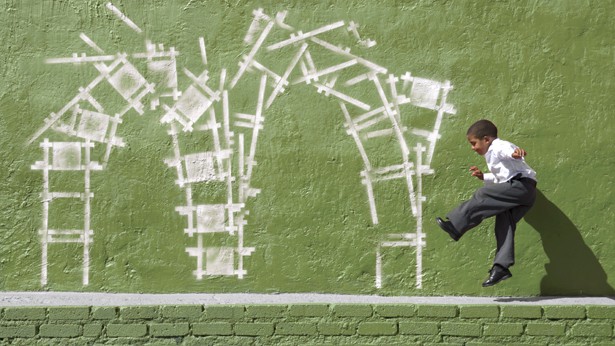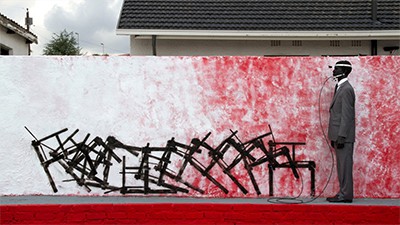735 Anderson Hill Road
Purchase, New York 10577
May 4–August 10, 2014

Rhode’s exuberant animations – created in the streets, studios, his parents’ yard in Johannesburg, and Berlin where he now lives and works – transform the quotidian into the playful and fantastic but include an underpinning of melancholy, danger, and risk. “I embrace chaos. I don’t create a work only with the idea that it has to be lighthearted; there’s something dark underneath,” Rhode explained at a recent visit to the Neuberger Museum of Art. “I come from a culture that is very spontaneous, that has a lot of humor and sarcasm. It stems from the South African mentality and has to do with freedom, and with the possibility of imagining or reinventing another world quite rapidly… Approachability and accessibility are fundamental to my work.”

“I was in high school in the early 1990s, a volatile period before the first democratic election, before Nelson Mandela became president. I remember moments when teachers stopped teaching for weeks. This period was referred to as a ‘Chalk Down.’ School was basically closed, and we were let loose, [to roam] the streets… We stole chalk from the classroom, drew objects on the walls, and made the [younger] kids interact with objects, as if the objects were real.” It was through art school that he formalized those experiences and assimilated them into his work. “You take material and change it into something else,” he said. “You steal the chalk used for educating, and use it to draw illegally on the concrete walls of the toilet. The subcultural language changes the meaning of the chalk. We drew the bicycle because we couldn’t afford to own bikes. You didn’t go to school with a bicycle, you never saw it, so it became an extension of a desire.”
According to Posner and Yelin, the artist “articulates drawing and movement; juxataposes sound and image; recycles everyday objects such as bicycles, chairs musical instruments and sports equipment.” At a meeting with the co-curators of Robin Rhode in Berlin in July, 2013, he explained: “I embrace the objects around me and certain aspects of the everyday. I’m not relying on a theory or concept. The experiential is what draws me to the everyday. I’m trying to decode a moment in a life, a life span, the life cycle.”
The bicycle looms large in Rhode’s work. “He recalls the bike he left behind in Cape Town when his family moved to Johannesburg, “ writes Yelin, “and the racial history of South Africa. During World War II, South African soldiers returning from the front were compensated according to race: white soldiers were given land; non-white soldiers were given bicycles.” Chairs also pervade his work. The artist’s inspiration for Piano Chair is South African pianist and composer Mosese Molelekwa, widely known as “the brightest hope for a renaissance of South Africa’s jazz culture,” according to his obituary in The Guardian. In 2001, he was found hanged at the age of twenty-seven. Piano Chair is Rhode’s homage to the musician. In this video a young man in blackface, stylishly attired in tailcoat and bowtie, and a drawing of a piano stool become partners in crime as they carry out the “murder” of a baby grand. The video, staged against a white wall in a drug-invested section of Johannesburg, is shrouded in violence, yet it is choreographed and performed with elegance and wit.
The human figure also looms large in Rhode’s animations. Whether it is Rhode’s or that of others who stand in for the artist, he dynamically renders bodies in motion. “Showcasing the actions of protagonists who walk, jump, skate, paint or draw, occasionally sit or stand still, hurl or mime the process of hurling objects, and, sometimes, appear to be flying, Rhode interrogates the very conditions of embodiment,” Posner and Yelin points out. Sometimes the figures appear to defy gravity or at least struggle with it as it represents “the ultimate limit to be spurned,” writes Gunning. “Rhodes images simultaneously … celebrate [the] possibilities but also …encounter the resistance of the material circumstances of the real world.”
Posner writes that Rhode also is interested in creating a bridge between his experience in South Africa with various movements in European and American modern and contemporary art. “He refashions artistic precursors and contemporaries such as Marcel Duchamp, Gerrit Rietveld, Mies van der Rohe, William Kentridge, and Richard Serra… He said that his post-apartheid generation was the first to experience the effects of globalization and to embrace such American influences as hip-hop and graffiti, basketball, advertising and the movies.”
Given his first major museum solo show by Haus der Kunst, Munich, Germany, in 2007, Robin Rhode has since had major solo exhibitions at a number of important museums around the world, including the Hayward Gallery, London (2008); The Wexner Center for the Arts, Columbus, Ohio (2009), Los Angeles County Museum of Art, California (2010), and the National Gallery of Victoria, Melbourne, Australia (2013). He has participated in notable group exhibitions, such as the 2012 Sydney Biennale; Staging Action: Performance in Photography Since 1960, Museum of Modern Art, New York, and Framed, Indianapolis Museum of Art, Indiana (both 2011); SITE Santa Fe Biennale and The Original Copy: Photography of Sculpture, 1839 to Today, Museum of Modern Art, New York (both 2010); the 51st Venice Biennale (2005); and New Photography, Museum of Modern Art, New York (2005). His work can be found in numerous public collections, including the Castello di Rivoli, Turin; Centre Pompidou, Paris; The Hirshhorn Museum and Sculpture Garden, Washington, D.C.; Johannesburg Art Gallery, South Africa; Perez Art Museum Miami, Florida; Musée d’Art Moderne de la Ville de Paris, France; Museum of Modern Art, Solomon R. Guggenheim Museum, Studio Museum in Harlem, New York; and Walker Art Center, Minneapolis.



